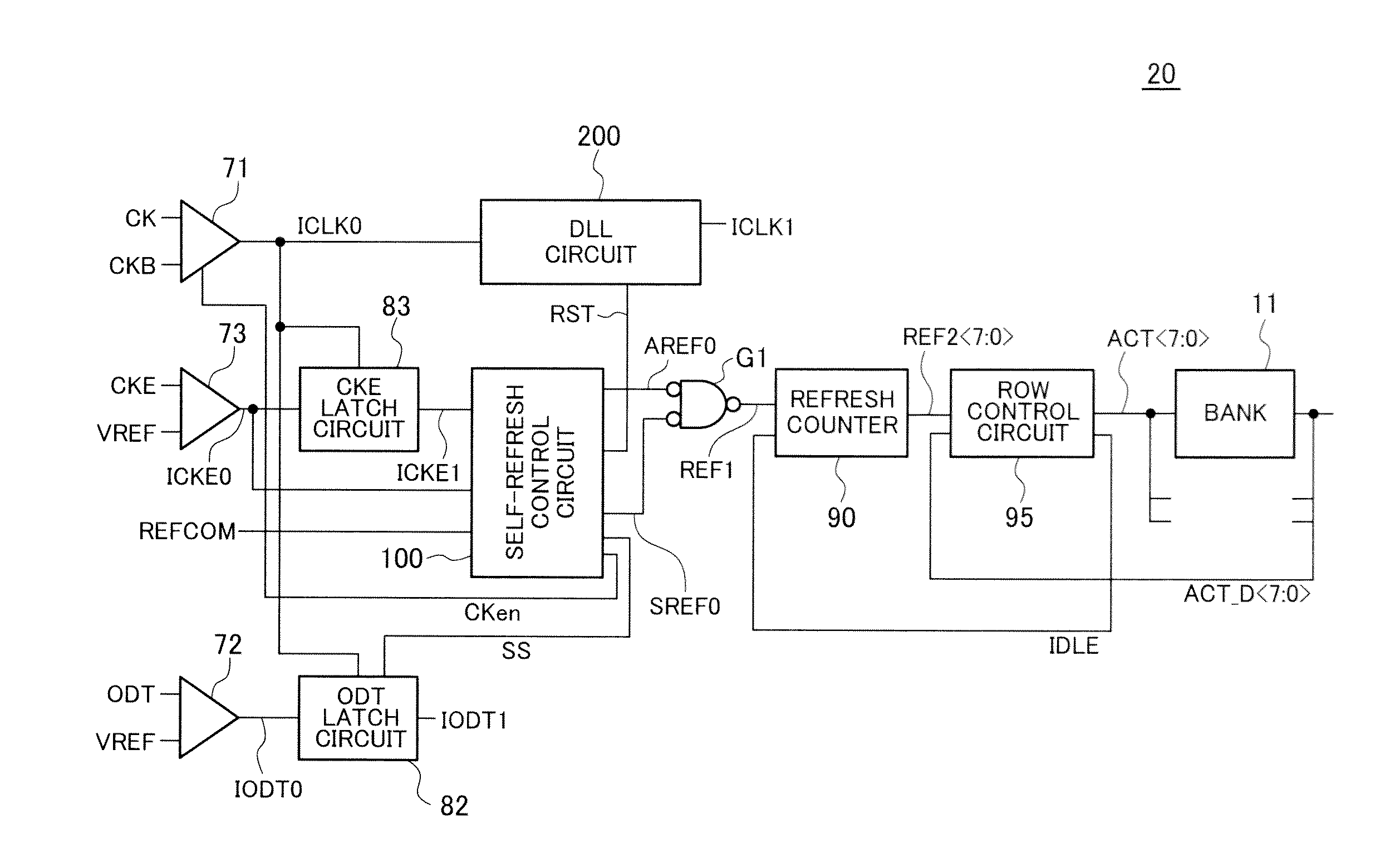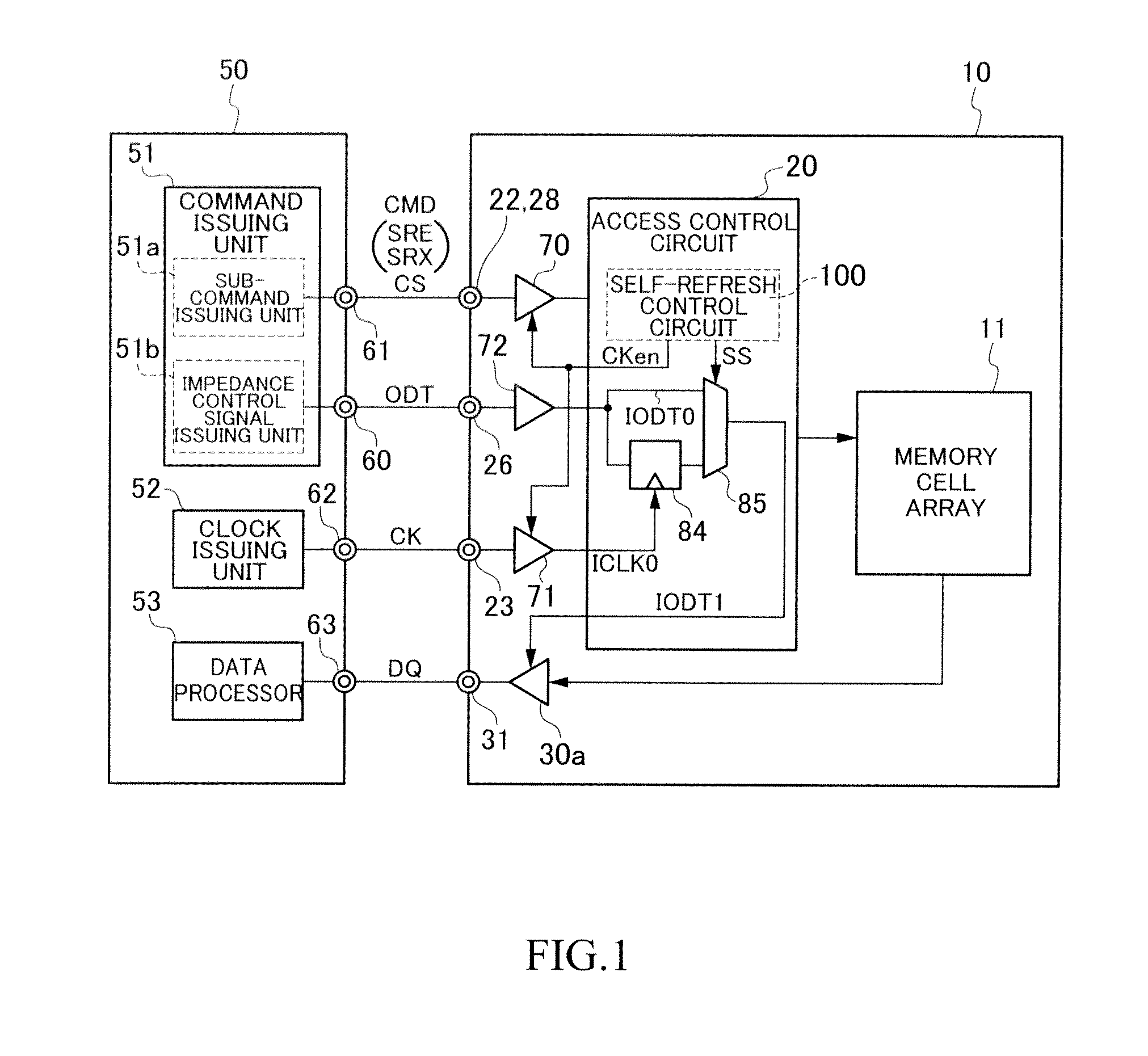Information processing system including semiconductor device having self-refresh mode
a technology of information processing system and self-refresh mode, which is applied in the field of information processing system, can solve the problems of power consumption of the entire system becoming quite low, inability to use impedance control signals, and power consumption being higher in power-down mode than in self-refresh mod
- Summary
- Abstract
- Description
- Claims
- Application Information
AI Technical Summary
Benefits of technology
Problems solved by technology
Method used
Image
Examples
first embodiment
[0062]Turning to FIG. 3, the access control circuit 0 includes input buffer circuits 71 to 73. The input buffer circuit 71 receives the external clock signals CK and CKB and generates the internal clock signal ICLK0, and is also referred to as “first input buffer circuit” in the present invention. The input buffer circuit 72 receives the impedance control signal ODT and generates an impedance control signal IODT0, and is also referred to as “second input buffer circuit” in the present invention. The input buffer circuit 73 receives the clock enable signal CKE and generates a clock enable signal ICKE0, and is also referred to as “third input buffer circuit” in the present invention. The input buffer circuit 71 is activated or inactivated according to an enable signal CKen. The input buffer circuit 71 is activated when the enable signal CKen is high. On the other hand, the input buffer circuits 72 and 73 are always activated. This is because, in the first embodiment, the impedance con...
third embodiment
[0103]When the self-refresh command SRE is issued at the time t32, the SR latch circuit L1 shown in FIG. 6 is set and the enable signal CKen is changed to a low level. This inactivates the input buffer circuits 71 and 72a shown in FIG. 10 and reduces power consumption. The impedance control signal CDT cannot be input during a period when the semiconductor device has entered the self-refresh mode. In FIG. 11, the periods in which input of the impedance control signal ODT is ineffective (Don't care) are shown by hatching. In the example shown in FIG. 11, the impedance control signal ODT is not input (that is, Don't care) in most of the period when the semiconductor device 10 is in the self-refresh mode. The impedance control signal ODT cannot be supplied from the controller 50 in most of the period when the semiconductor device 10 is in the self-refresh mode because the input buffer circuit 72a is inactivated in this period. Specifically, logic of generating the enable signal CKen sho...
fourth embodiment
[0142]the present invention is explained next.
[0143]An access control circuit according to the fourth embodiment has a configuration in which the self-refresh control circuit 100b is replaced by a self-refresh control circuit 100c. Other features of the access control circuit of the fourth embodiment are basically the same as those of the access control circuit 20b shown in FIG. 15.
[0144]Turning to FIG. 18, the self-refresh control circuit 100c is different from the self-refresh control circuit 100b shown in FIG. 16 in that the one-shot pulse generating circuit OP1 is used instead of the oscillator 150. A signal supplied to the set node S of the SR latch circuit L1 is used as it is as the self-refresh signal SREF0. Output from the one-shot pulse generating circuit OP1 is used as the update start signal ST. Other features of the self-refresh control circuit 100a are basically the same as those of the self-refresh control circuit 100b shown in FIG. 16, and therefore like elements are ...
PUM
 Login to View More
Login to View More Abstract
Description
Claims
Application Information
 Login to View More
Login to View More - R&D
- Intellectual Property
- Life Sciences
- Materials
- Tech Scout
- Unparalleled Data Quality
- Higher Quality Content
- 60% Fewer Hallucinations
Browse by: Latest US Patents, China's latest patents, Technical Efficacy Thesaurus, Application Domain, Technology Topic, Popular Technical Reports.
© 2025 PatSnap. All rights reserved.Legal|Privacy policy|Modern Slavery Act Transparency Statement|Sitemap|About US| Contact US: help@patsnap.com



